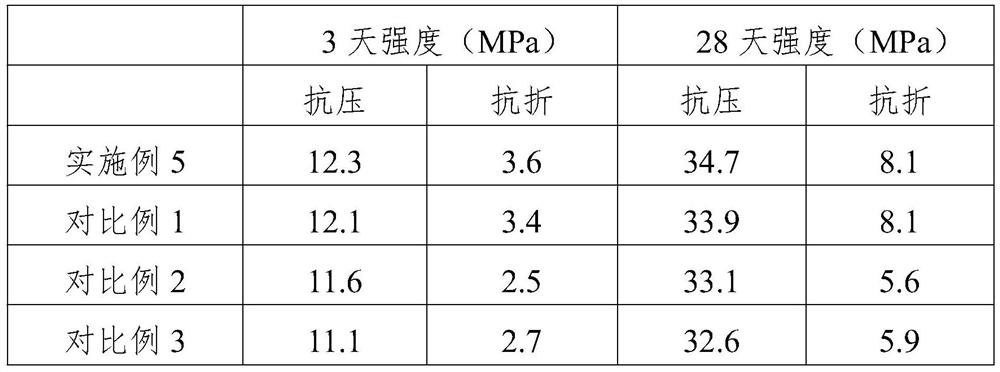Energy-saving and environment-friendly building cement and production process thereof
An energy-saving, environment-friendly and construction technology, applied in the field of construction cement, can solve the problems of pollution, inability to recycle, waste of resources, etc., and achieve the effects of high strength, small pores and large specific surface area.
- Summary
- Abstract
- Description
- Claims
- Application Information
AI Technical Summary
Problems solved by technology
Method used
Image
Examples
Embodiment 1
[0038] An energy-saving and environment-friendly building cement. The cement comprises the following raw materials in parts by weight: 70 parts of limestone, 10 parts of lead-zinc tailings, 2 parts of dihydrate gypsum, 1 part of modified triethanolamine, 5 parts of steel slag, and 10 parts of fly ash , 5 parts of waste tire powder, 10 parts of rice husk.
[0039] The preparation method of modified triethanolamine is:
[0040] (1) earlier triethanolamine is dropped in the four-necked flask A that has stirring paddle, then in the four-necked flask A, add the p-toluenesulfonic acid of reactant total amount 3% as catalyst;
[0041] (2) At 110°C and a stirring speed of 40r / min, add maleic anhydride to the four-necked flask A in batches, the molar ratio of maleic anhydride and triethanolamine is 1.2:1, and react until the acid value in the system is Until it is no longer reduced, triethanolamine maleate is obtained, and triethanolamine maleate is mixed with 50% triethanolamine male...
Embodiment 2
[0051] An energy-saving and environment-friendly building cement. The cement includes the following raw materials in parts by weight: 80 parts of limestone, 14 parts of lead-zinc tailings, 3 parts of dihydrate gypsum, 3 parts of modified triethanolamine, 10 parts of steel slag, and 20 parts of fly ash , 10 parts of waste tire powder, 15 parts of rice husk.
[0052] The preparation method of modified triethanolamine is consistent with the preparation method of modified triethanolamine in Example 1.
[0053] The cement production process is:
[0054] (1) Weigh the raw materials according to the proportion, mix and pulverize limestone, lead-zinc tailings, steel slag and rice husk, and grind them finely by a ball mill to prepare raw meal;
[0055] (2) After heating the cement pit to 300°C, put the raw material prepared in step (1) into the cement pit, heat the cement pit to 1350°C for calcination, take it out after high-temperature calcination, and naturally cool to room temperat...
Embodiment 3
[0059] An energy-saving and environment-friendly building cement, comprising the following raw materials in parts by weight: 70 parts of limestone, 14 parts of lead-zinc tailings, 2 parts of dihydrate gypsum, 3 parts of modified triethanolamine, 5 parts of steel slag, and 20 parts of fly ash , 5 parts of waste tire powder, 15 parts of rice husk.
[0060] The preparation method of modified triethanolamine is consistent with the preparation method of modified triethanolamine in Example 1.
[0061] The cement production process is:
[0062] (1) Weigh the raw materials according to the proportion, mix and pulverize limestone, lead-zinc tailings, steel slag and rice husk, and grind them finely by a ball mill to prepare raw meal;
[0063] (2) After heating the cement pit to 200°C, put the raw material prepared in step (1) into the cement pit, heat the cement pit to 1350°C for calcination, take it out after high-temperature calcination, and naturally cool to room temperature to obta...
PUM
| Property | Measurement | Unit |
|---|---|---|
| particle size | aaaaa | aaaaa |
Abstract
Description
Claims
Application Information
 Login to View More
Login to View More - R&D
- Intellectual Property
- Life Sciences
- Materials
- Tech Scout
- Unparalleled Data Quality
- Higher Quality Content
- 60% Fewer Hallucinations
Browse by: Latest US Patents, China's latest patents, Technical Efficacy Thesaurus, Application Domain, Technology Topic, Popular Technical Reports.
© 2025 PatSnap. All rights reserved.Legal|Privacy policy|Modern Slavery Act Transparency Statement|Sitemap|About US| Contact US: help@patsnap.com

